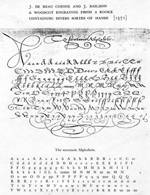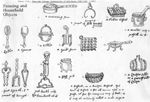
|
Examples of Secretary Handwriting & Cracking the 'Code' Secretary Hand predominated at this time. The introduction of printing into C15th Europe would bring reading and writing to a wider and more diverse audience. It also made the medieval copyist more or less obsolete. His place was taken by the writing master. His position was ambiguous: higher than that of a craftsman; not quite as high as that of a scholar. Writing masters taught their craft in schools, to private pupils and also published their copies to gain fame, recognition of their individual styles and no doubt also to increase their commercial viability.22 One of the first English copybooks is this A Booke Containing Divers Sortes of Hands, 1571, by John de Beauchesne and John Baildon. Even young children may enjoy deciphering this handwriting, especially when it is married, as in this case, to an everyday context. Recognition of the sketch of a spoon, number 6, permits the easy reading of the script, (noting the additional 'e'). A much bigger spoon for doling out soup may be identified as the 'ladle', number 5 and so on. Number 7, 'the kettle', permits a discussion of how water was then brought to the boil and points up a difference with the present age. The 'pot rack with brandrett' [or brandreth] may be pursued in the Oxford English Dictionary and it is easy to see how a vessel's contents could be warmed or cooled by degrees up or down of the ratchet. The Essex Record Office publication by Hilda Grieve entitled Examples of English Handwriting, 1150-1750 is justly viewed as a manual for palaeography with a nation-wide celebrity. Plate V, for example, the Churchwardens' Accounts of Great Dunmow, 1540, can be copied and pored over with some glee.
|
||||||||
 |

